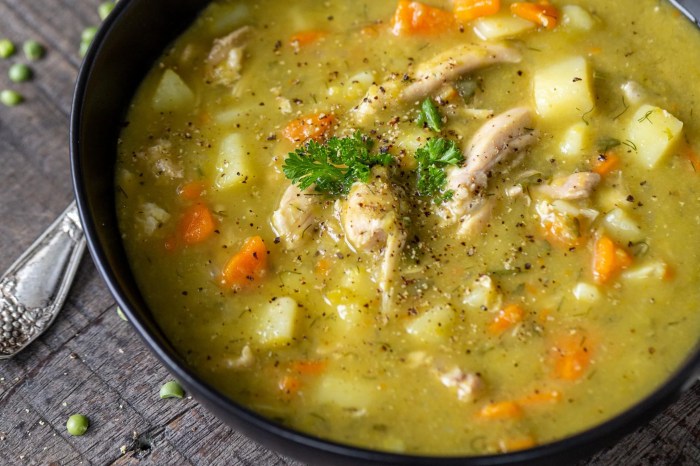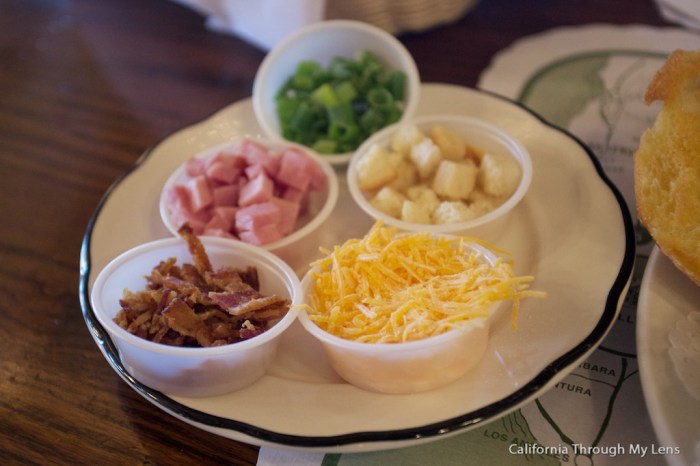Pea Soup in the Time of Hans Christian Andersen
Pea soup andersen’s recipe – This article explores the historical context of pea soup in 19th-century Denmark, examines Hans Christian Andersen’s potential exposure to the dish, and culminates in the creation of a speculative recipe inspired by the era. We will then compare this speculative recipe with modern versions, highlighting the evolution of this classic dish.
Historical Context of Pea Soup in Andersen’s Time
Pea soup held a significant place in 19th-century Danish cuisine, particularly among the working and lower-middle classes. Its affordability and nutritional value made it a staple food. Typical ingredients included split peas, pork (often including bones for richer broth), onions, carrots, and herbs like parsley or thyme. Preparation involved simmering the ingredients for an extended period, resulting in a hearty and flavorful soup.
The social significance stemmed from its prevalence in everyday meals; it wasn’t just sustenance but a common thread connecting people across social strata, albeit with variations in richness depending on economic status. Modern pea soup recipes often feature simpler preparations, sometimes omitting meat entirely and emphasizing creaminess. While some retain traditional elements, many modern versions prioritize speed and convenience over the lengthy simmering process of the past.
Andersen’s Potential Exposure to Pea Soup Recipes
Given the ubiquity of pea soup in 19th-century Denmark, it’s highly probable that Andersen encountered it frequently. Potential sources include family traditions—his childhood was marked by modest circumstances—and the cookbooks available at the time, which likely featured various pea soup recipes. While there’s no direct evidence of Andersen documenting pea soup in his writings or journals, his works often contain detailed descriptions of food and mealtimes, suggesting a keen awareness of culinary practices.
Indirect references to simple, nourishing foods in his fairy tales, such as the porridge in “The Little Match Girl,” hint at a familiarity with the everyday fare of his time, including the likely presence of pea soup.
Speculative Recipe Creation Based on Era and Context

Source: momsdish.com
This speculative recipe aims to capture the essence of a 19th-century Danish pea soup. It prioritizes simplicity and utilizes ingredients readily available during Andersen’s time.
| Ingredient | Quantity |
|---|---|
| Split peas | 1 cup |
| Pork knuckle or rind | 1 lb |
| Onion, chopped | 1 large |
| Carrot, chopped | 1 medium |
| Celery, chopped | 1 stalk |
| Water | 8 cups |
| Salt and pepper | To taste |
| Fresh parsley, chopped | For garnish |
Preparation:
- Combine all ingredients (except parsley) in a large pot.
- Bring to a boil, then reduce heat and simmer for at least 2 hours, or until peas are very tender.
- Remove pork and let cool. Shred meat and return some to the soup (reserve some for later use).
- Season with salt and pepper to taste.
- Garnish with fresh parsley before serving.
Visual Representation of the Speculative Recipe, Pea soup andersen’s recipe

Source: californiathroughmylens.com
The pea soup would have a thick, creamy consistency, a muted green color from the peas, and a slightly cloudy broth due to the simmering process. The pork would add flecks of grayish-white throughout. The aroma would be savory and comforting, with hints of pork and earthy peas. The taste would be rich and hearty, with a subtle sweetness from the carrots and a depth of flavor from the long simmering.
It would likely be served in simple bowls, perhaps with a slice of crusty bread, reflecting the dining customs of the time.
Comparative Analysis of Different Pea Soup Recipes
Comparing our speculative recipe with three modern online recipes reveals significant differences. Modern recipes often incorporate ingredients not commonly available in the 19th century, such as bay leaves or different types of smoked meats. Modern recipes also emphasize speed and convenience, frequently using pressure cookers to shorten the simmering time. The resulting flavor profiles vary greatly, with some leaning towards smoother textures and creamier consistencies.
The table below Artikels a comparison of our speculative recipe with three hypothetical modern variations.
| Feature | Speculative 19th-Century Recipe | Modern Recipe 1 (Creamy) | Modern Recipe 2 (Spicy) | Modern Recipe 3 (Vegetarian) |
|---|---|---|---|---|
| Primary Protein | Pork knuckle | Ham Hock | Andouille Sausage | None |
| Simmering Time | 2+ hours | 1 hour (pressure cooker) | 45 minutes (pressure cooker) | 1 hour |
| Texture | Thick, chunky | Smooth, creamy | Thick, slightly spicy | Thick, slightly chunky |
| Flavor Profile | Savory, hearty, subtle sweetness | Rich, creamy, savory | Spicy, savory, smoky | Earthy, savory, slightly sweet |
Essential FAQs: Pea Soup Andersen’s Recipe
What type of peas were commonly used in 19th-century Denmark?
Split peas were prevalent, though the specific variety might vary regionally.
Were there any common variations or regional differences in pea soup recipes during Andersen’s time?
Yes, regional variations likely existed, with differences in ingredients and preparation methods depending on location and available resources.
While Pea Soup Andersen’s recipe emphasizes simple, hearty ingredients, a contrasting approach is found in vibrant Asian cuisine. For a completely different flavor profile, consider exploring the complex spice blend of p f chang’s hot and sour soup recipe , which showcases a delicious tang. Returning to Andersen’s recipe, the subtle nuances of its preparation offer a comforting counterpoint to the more assertive flavors of the Asian-inspired soup.
How was pea soup typically served in 19th-century Denmark?
It was often served as a hearty main course, possibly with sides like bread or cured meats.
Is there any evidence Andersen himself enjoyed pea soup?
Direct evidence is lacking, but the prevalence of pea soup in Danish cuisine at the time makes it highly probable he encountered it.
